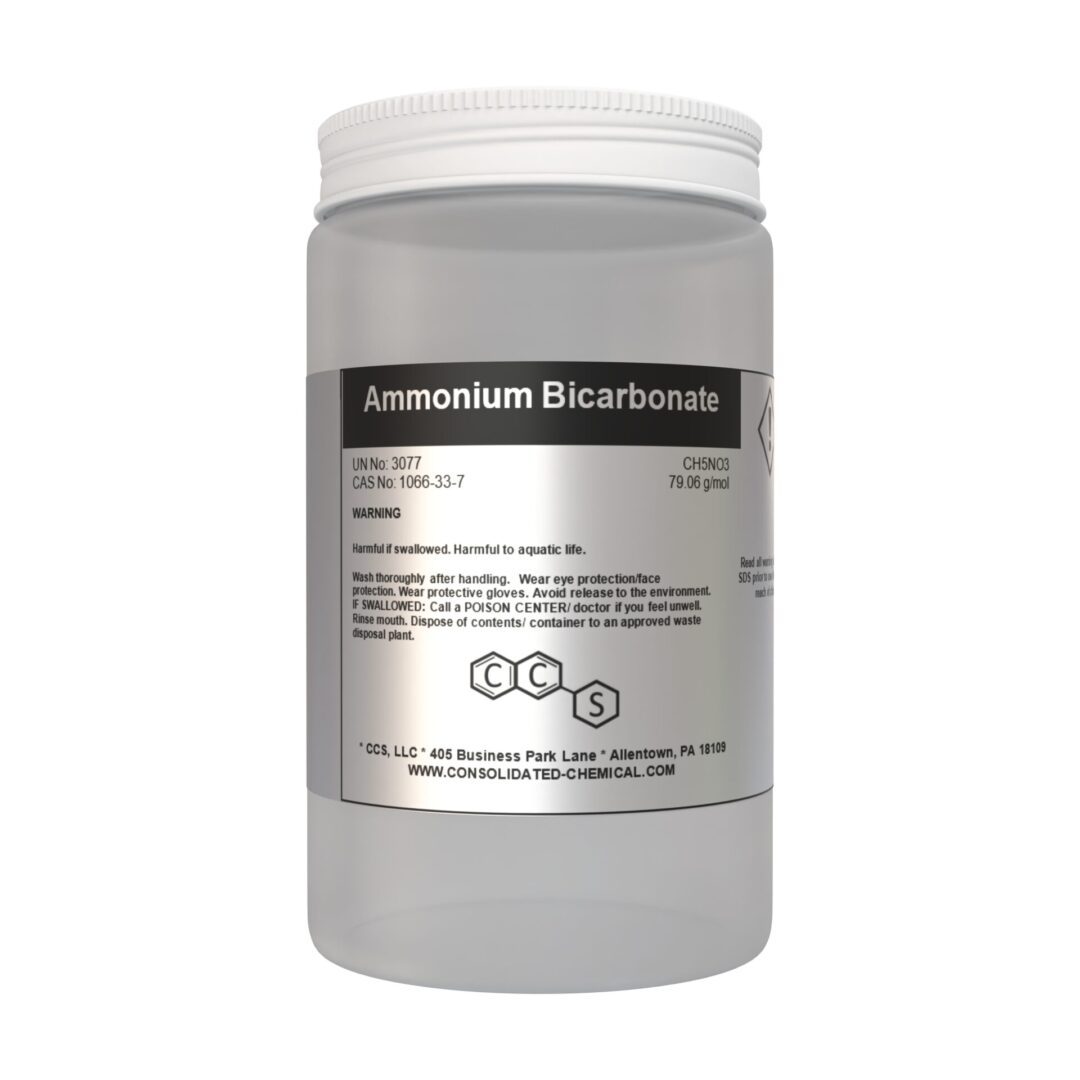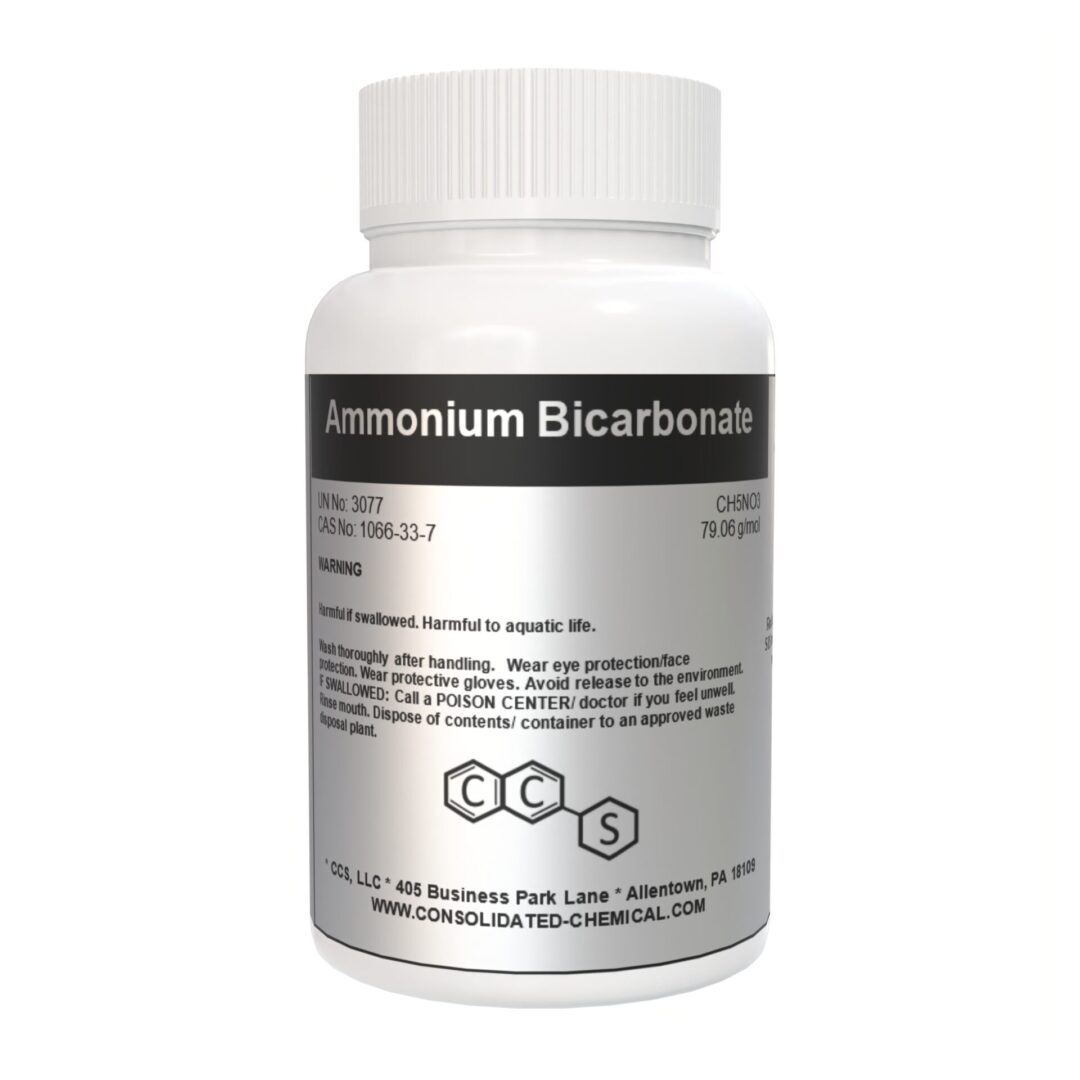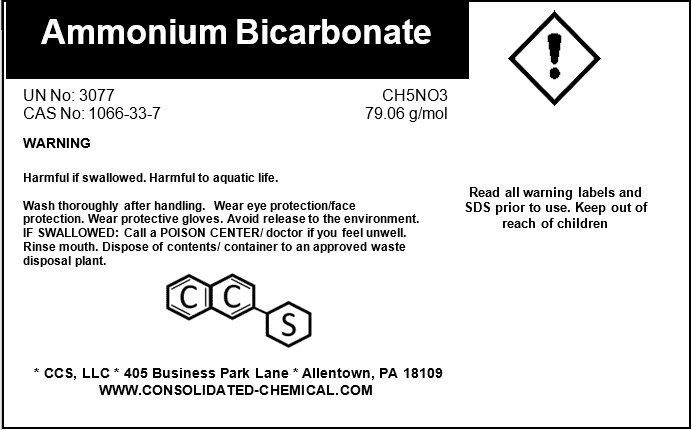Ammonium Bicarbonate – Food Grade – Leavening Agent
$12.99 – $27.00
General Information
- Chemical Name: Ammonium Bicarbonate
- Synonyms: Baking Ammonia, Ammonium Hydrogen Carbonate
- CAS Number: 1066-33-7
- EC Number: 213-911-5
- Molecular Formula: NH₄HCO₃
- Molecular Weight: 79.06 g/mol
- Grade: Food and Industrial Grade
Physical Properties
- Appearance: White crystalline powder
- Odor: Mild ammonia odor
- Purity: ≥ 99%
- pH: 7.8–8.5 (1% solution)
- Density: ~1.58 g/cm³ at 20°C
- Melting Point: Decomposes at ~60°C into ammonia, carbon dioxide, and water
- Solubility:
- Fully soluble in water (11.9 g/100 mL at 25°C)
- Insoluble in alcohol
Chemical Properties
- Stability:
- Stable under normal conditions when stored in a cool, dry environment.
- Decomposes at elevated temperatures or when exposed to acids or moisture.
- Decomposition Products: Ammonia, carbon dioxide, and water.
Description
Ammonium Bicarbonate is a high-purity compound widely used in food, industrial, and cleaning applications. It serves as a key leavening agent in baking and confectionery processes, ensuring light and fluffy textures in baked goods. With its eco-friendly decomposition properties, it is also a preferred choice for industrial cleaning, buffering, and chemical synthesis.
Applications of Ammonium Bicarbonate – High-Quality Food and Industrial Grade
Food Industry
- Leavening Agent:
- Used in baking for cookies, crackers, and biscuits to provide a light and fluffy texture without leaving residual flavor.
- Food Additive:
- Improves the texture, stability, and consistency of processed foods.
- Confectionery:
- Utilized in making light, crispy candies and other sweet treats.
Cleaning Solutions
- Industrial Cleaning:
- Effectively removes grease, grime, and deposits in industrial equipment.
- Commonly used in brewery and beverage equipment cleaning for its eco-friendly decomposition properties.
Chemical Industry
- Buffering Agent:
- Maintains pH stability in chemical formulations.
- Chemical Synthesis:
- Acts as an intermediate in the production of dyes, pigments, ceramics, and catalysts.
Agriculture
- Fertilizer Component:
- Provides nitrogen to the soil, enhancing crop growth and productivity.
- Soil Conditioning:
- Used as an eco-friendly alternative to adjust soil alkalinity.
Laboratory Applications
- Reagent:
- Used in analytical procedures for the preparation of ammonium salts.
- Buffer Preparation:
- Provides stability for laboratory experiments and chemical processes.
Textile and Dye Industry
- Fabric Treatment:
- Used in processing and dyeing textiles to ensure color fastness and improve fabric quality.
Environmental Applications
- Air Pollution Control:
- Used in reducing emissions in certain industrial processes.
Pulp and Paper Industry
- Processing Aid:
- Helps improve paper quality during the pulping and bleaching stages.
Storage Instructions:
- Cool, Dry Environment: Store in a cool, dry place away from moisture and direct sunlight to prevent premature decomposition.
- Temperature Control: Maintain storage temperature below 25°C (77°F) to ensure stability.
- Sealed Containers: Keep the product in its original, airtight packaging or transfer it to moisture-resistant, resealable containers after opening.
- Ventilation: Ensure storage in a well-ventilated area to avoid the accumulation of released gases.
- Separation: Store away from acids, strong oxidizing agents, and heat sources.
Handling Instructions:
- Personal Protective Equipment (PPE):
- Wear gloves, safety goggles, and a dust mask when handling to prevent skin contact and inhalation of dust.
- Minimize Dust Formation:
- Handle gently to avoid the creation of airborne dust, which may cause irritation.
- Safe Transfer:
- Use clean, dry tools and equipment to transfer the product safely.
- Spill Management:
- Sweep up spills promptly using dry, non-sparking tools. Dispose of waste according to local regulations.
- Hygiene Practices:
- Wash hands thoroughly after handling. Avoid eating, drinking, or smoking in the work area.
Precautions During Use:
- Avoid exposing the product to high temperatures (above 60°C) as it will decompose into ammonia, carbon dioxide, and water.
- Ensure proper ventilation during use to manage any released gases.
Additional information
| Size | 250 GRAMS, 500 GRAMS, 1000 GRAMS |
|---|
Related products
-
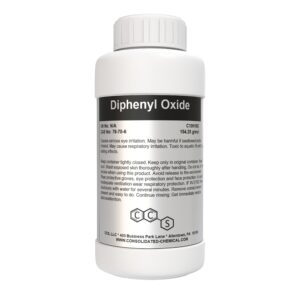
Diphenyl Oxide (Diphenyl Ether) | Chemical & Fragrance Ingredient
$12.00 – $49.99 Select options This product has multiple variants. The options may be chosen on the product page -
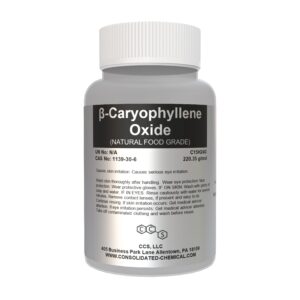
B-Caryophyllene Oxide | Natural Food Grade
$12.00 – $19.99 Select options This product has multiple variants. The options may be chosen on the product page -
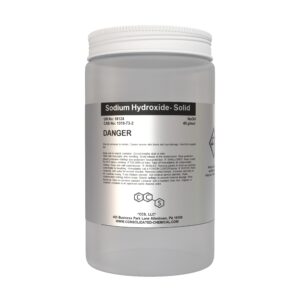
Sodium Hydroxide Beads – Premium Quality Lye 1kg (2.2lb)
$22.00 Add to cart -
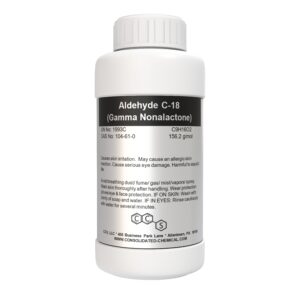
Aldehyde C-18 (Gamma Nonalactone) | Fragrance Compound
$9.99 – $42.00 Select options This product has multiple variants. The options may be chosen on the product page
SKU: N/A
Categories: Food Additive, Leavening Agent
Tags: Ammonium Bicarbonate, ammonium bicarbonate 99.9%, ammonium bicarbonate 99%, ammonium bicarbonate acidity regulator, ammonium bicarbonate ACS grade, ammonium bicarbonate advanced formulations, ammonium bicarbonate bakery applications, ammonium bicarbonate baking ingredient, ammonium bicarbonate baking soda substitute, ammonium bicarbonate best formulation practices, ammonium bicarbonate best supplier, ammonium bicarbonate biodegradable, ammonium bicarbonate buffering agent, ammonium bicarbonate bulk pricing, Ammonium Bicarbonate Bulk Supplier, ammonium bicarbonate commercial availability, ammonium bicarbonate competitive pricing, ammonium bicarbonate cost, ammonium bicarbonate cost-effective solutions, ammonium bicarbonate cutting-edge technology, ammonium bicarbonate distributor, ammonium bicarbonate DOT regulations, ammonium bicarbonate E503, ammonium bicarbonate eco-friendly, ammonium bicarbonate emergency response, ammonium bicarbonate emerging markets, ammonium bicarbonate environmental impact, ammonium bicarbonate EPA regulations, ammonium bicarbonate EU regulations, ammonium bicarbonate excipient, ammonium bicarbonate experimental studies, ammonium bicarbonate FCC grade, ammonium bicarbonate FDA approved, ammonium bicarbonate first aid measures, ammonium bicarbonate food additive, ammonium bicarbonate food grade, Ammonium Bicarbonate for Agriculture, Ammonium Bicarbonate for Baking, Ammonium Bicarbonate for Breweries, Ammonium Bicarbonate for Chemical Synthesis, Ammonium Bicarbonate for Cleaning, Ammonium Bicarbonate for Dyes and Pigments, Ammonium Bicarbonate for Fertilizers, Ammonium Bicarbonate for Food Processing, Ammonium Bicarbonate for Industrial Use, Ammonium Bicarbonate for Sale, Ammonium Bicarbonate for Textiles, ammonium bicarbonate GHS classification, ammonium bicarbonate global distribution, ammonium bicarbonate green chemistry, ammonium bicarbonate handling precautions, ammonium bicarbonate hazard classification, ammonium bicarbonate high purity, ammonium bicarbonate high-efficiency formulations, ammonium bicarbonate import/export, ammonium bicarbonate in adhesives, ammonium bicarbonate in aerospace applications, ammonium bicarbonate in agriculture, ammonium bicarbonate in agrochemicals, ammonium bicarbonate in alternative chemistry, ammonium bicarbonate in alternative energy, ammonium bicarbonate in analytical chemistry, ammonium bicarbonate in animal feed, ammonium bicarbonate in aquaculture, ammonium bicarbonate in automotive industry, ammonium bicarbonate in baked goods, ammonium bicarbonate in battery technology, ammonium bicarbonate in biochemistry, ammonium bicarbonate in biotechnology, ammonium bicarbonate in candy production, ammonium bicarbonate in carbonated beverages, ammonium bicarbonate in ceramics, ammonium bicarbonate in cheese processing, ammonium bicarbonate in chemical synthesis, ammonium bicarbonate in chromatography, ammonium bicarbonate in cleaning agents, ammonium bicarbonate in CO2 capture, ammonium bicarbonate in coatings, ammonium bicarbonate in confectionery, ammonium bicarbonate in cookies, ammonium bicarbonate in corrosion control, ammonium bicarbonate in cosmetics, ammonium bicarbonate in crackers, ammonium bicarbonate in dairy products, ammonium bicarbonate in deodorants, ammonium bicarbonate in deodorizing applications, ammonium bicarbonate in detergents, ammonium bicarbonate in dietary supplements, ammonium bicarbonate in drug formulations, ammonium bicarbonate in electroplating, ammonium bicarbonate in emerging industries, ammonium bicarbonate in energy storage, ammonium bicarbonate in fertilizers, ammonium bicarbonate in fuel cells, ammonium bicarbonate in functional foods, ammonium bicarbonate in gas scrubbing, ammonium bicarbonate in glass manufacturing, ammonium bicarbonate in hair care, ammonium bicarbonate in herbicides, ammonium bicarbonate in high-tech manufacturing, ammonium bicarbonate in household cleaners, ammonium bicarbonate in hydrogen production, ammonium bicarbonate in industrial applications, ammonium bicarbonate in industrial cleaning, ammonium bicarbonate in industrial formulations, ammonium bicarbonate in laundry products, ammonium bicarbonate in leather tanning, ammonium bicarbonate in lotions, ammonium bicarbonate in material science, ammonium bicarbonate in metal treatment, ammonium bicarbonate in nanotechnology, ammonium bicarbonate in new product development, ammonium bicarbonate in nutraceuticals, ammonium bicarbonate in odor control, ammonium bicarbonate in paints, ammonium bicarbonate in pastry, ammonium bicarbonate in performance-driven formulations, ammonium bicarbonate in personal care, ammonium bicarbonate in pesticides, ammonium bicarbonate in pharmaceuticals, ammonium bicarbonate in plant growth, ammonium bicarbonate in plastics, ammonium bicarbonate in pollution control, ammonium bicarbonate in polymers, ammonium bicarbonate in poultry farming, ammonium bicarbonate in precision manufacturing, ammonium bicarbonate in protein powders, ammonium bicarbonate in regulatory updates, ammonium bicarbonate in resins, ammonium bicarbonate in rubber processing, ammonium bicarbonate in sealants, ammonium bicarbonate in shampoos, ammonium bicarbonate in skincare, ammonium bicarbonate in smart material applications, ammonium bicarbonate in soft drinks, ammonium bicarbonate in soil conditioning, ammonium bicarbonate in spectroscopy, ammonium bicarbonate in sports nutrition, ammonium bicarbonate in sustainable chemistry, ammonium bicarbonate in sustainable production, ammonium bicarbonate in textile processing, ammonium bicarbonate in veterinary medicine, ammonium bicarbonate in wastewater treatment, ammonium bicarbonate in water purification, ammonium bicarbonate industrial grade, ammonium bicarbonate industrial safety, ammonium bicarbonate industrial supply, ammonium bicarbonate industry demand, ammonium bicarbonate industry-leading product, ammonium bicarbonate innovative applications, ammonium bicarbonate international trade, ammonium bicarbonate laboratory reagent, Ammonium Bicarbonate Leavening Agent, ammonium bicarbonate livestock supplement, ammonium bicarbonate long shelf life, ammonium bicarbonate manufacturer, ammonium bicarbonate market trends, ammonium bicarbonate next-generation products, ammonium bicarbonate nitrogen source, ammonium bicarbonate odor neutralizer, ammonium bicarbonate performance-enhancing ingredient, ammonium bicarbonate personal protective equipment, ammonium bicarbonate pH regulator, ammonium bicarbonate pharmaceutical grade, ammonium bicarbonate pharmaceutical intermediate, ammonium bicarbonate powder, ammonium bicarbonate premium quality, ammonium bicarbonate price, ammonium bicarbonate procurement, ammonium bicarbonate quality control, ammonium bicarbonate REACH certification, ammonium bicarbonate reaction catalyst, ammonium bicarbonate reagent grade, ammonium bicarbonate regulatory compliance, ammonium bicarbonate renewable, ammonium bicarbonate research and development, ammonium bicarbonate safety guidelines, ammonium bicarbonate scientific research, ammonium bicarbonate spill management, ammonium bicarbonate storage conditions, ammonium bicarbonate strategic sourcing, ammonium bicarbonate superior performance, ammonium bicarbonate supply chain, ammonium bicarbonate supply chain optimization, ammonium bicarbonate technical grade, ammonium bicarbonate testing, ammonium bicarbonate transport regulations, ammonium bicarbonate US regulations, ammonium bicarbonate USP grade, ammonium bicarbonate verified distributor, ammonium bicarbonate verified supplier, ammonium bicarbonate waste disposal, ammonium bicarbonate wholesale, Ammonium Hydrogen Carbonate, Baking Ammonia, buy ammonium bicarbonate, Buy Ammonium Bicarbonate Online, Eco-Friendly Leavening Agent, Food Grade Ammonium Bicarbonate, Food-Grade Leavening Compound, High-Purity Ammonium Bicarbonate, High-Quality Baking Ammonia, Industrial Cleaning Compound, Industrial Grade Ammonium Bicarbonate, Reliable Ammonium Bicarbonate, Safe and Pure Ammonium Bicarbonate, Versatile Ammonium Bicarbonate


